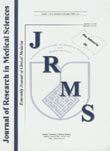فهرست مطالب

Journal of Research in Medical Sciences
Volume:22 Issue: 10, 2017 Oct
- تاریخ انتشار: 1396/09/02
- تعداد عناوین: 7
-
-
Page 1BackgroundCox proportional hazard model is the most common method for analyzing the effects of several variables on survival time. However, under certain circumstances, parametric models give more precise estimates to analyze survival data than Cox. The purpose of this study was to investigate the comparative performance of Cox and parametric models in a survival analysis of factors affecting the event time of neuropathy in patients with type 2 diabetes.Materials And MethodsThis study included 371 patients with type 2 diabetes without neuropathy who were registered at Fereydunshahr diabetes clinic. Subjects were followed up for the development of neuropathy between 2006 to March 2016. To investigate the factors influencing the event time of neuropathy, significant variables in univariate model (PResultsUsing KaplanMeier, survival time of neuropathy was computed 76.6 ± 5 months after initial diagnosis of diabetes. After multivariate analysis of Cox and parametric models, ethnicity, high?density lipoprotein and family history of diabetes were identified as predictors of event time of neuropathy (PConclusionAccording to AIC, log?normal model with the lowest Akaikes was the best?fitted model among Cox and parametric models. According to the results of comparison of survival receiver operating haracteristics curves, log?normal model was considered as the most efficient and fitted model.Keywords: Cox proportional hazards model, diabetes, Kaplan–Meier, neuropathy, parametric models
-
Page 2Aim: We sought the prevalence of food insecurity and whether cardiovascular risk markers and metabolic syndrome components are significantly different in categories of food insecurity in patients with type 2 diabetes.Materials And MethodsIn this cross?sectional study, 520 patients with type 2 diabetes from the Kerman coronary artery disease risk study aged between 23 and 87 years (60.8 ± 11.4) who selected by one?stage cluster sampling were assigned into four groups of food secure and mild, moderate, and severe food insecure. Household food insecurity was assessed by a 9?item household food insecurity access scale questionnaire.ResultsThe prevalence of food security and mild, moderate, and severe food insecurity in patients with diabetes was 24.4%, 33.1%, 28.9%, and 13.6%, respectively. There was a significant difference among the food?secure/insecure sex groups (P = 0.001). The prevalence of food insecurity and risk factors such as total cholesterol, high low?density lipoprotein cholesterol, and visceral obesity in mild food?insecure females was significantly higher than males (P onclusions: Food insecurity may deteriorate some cardiometabolic biomarkers in type 2 diabetes. Improving food security in patients with diabetes may help reduce cardiovascular disease.Keywords: Cardiovascular risk markers_food insecurity_Kerman coronary artery disease risk study_metabolic syndrome components_type 2 diabetes
-
Page 4BackgroundHepatitis B is a dangerous disease with high morbidity and mortality rates all around the world. Vaccination is the most important way to its prevention and control. This cross?sectional study was carried out to study the levels of immunogenicity to hepatitis B vaccine in students.Materials And MethodsSix hundred and forty?four students aged 618 years including 316 girls and 328 boys were selected from the Chaharmahal Va Bakhtiari province. Selected students had been received three doses of recombinant vaccine (0, 1, and 6 months). Blood samples were taken and the titers of hepatitis B surface antigen were studied.ResultsFrom a total of 644 students, 396 (61.5%) had a titer lesser than 10 mIu/ml and 248 (38.5%) had a titer higher than 10 mIu/ml. Therefore, the level of respond to vaccine with 95% confidence was 38.5% (34.7%42.4%). Levels of respond to vaccine were related to age, body mass index (BMI), and educational level and were not related to sex and habit of students.ConclusionsReverse significant relation was seen between the respond to vaccine and age and BMI in a way which the titers of antibody were lower in students with higher age and BMI.Keywords: Hepatitis B_immunization_body mass index_age_hepatitis B surface antigen
-
Page 5Angiogenesis is critical for oxygen and nutrient delivery to proliferating tumor cells. Th erefore, as angiogenesis is required and vital for the tumor growth and metastasis. Antiangiogenic therapy is considered to be benefi cial for tumor growth prevention due to starvation of tumor of oxygen and nutrients, but in some cases, the benefi ts are not permanent. Tyrosine kinase inhibitors and many other agents often target angiogenesis through inhibition of the vascular ndothelial growth factor (VEGF) pathway. Although preclinical studies showed satisfactory outcomes in tumor growth inhibition, antiangiogenic therapy in the clinical setting may not be eff ective.Th e resistance bserved in several tumor types through alternative angiogenic escape pathways contributes to restoration of tumor growth and may induce rogression, enhancement of invasion, and metastasis. Th erefore, tivation of major compensatory angiogenic pathways, sustaining tumor angiogenesis during VEGF blockade contributing to the recurrence of tumor growth overcome antiangiogenic strategies. In this review, we summarize the novel mechanisms involved in evasive resistance to antiangiogenic therapies and represent diff erent cancer types which have the ability to adapt to VEGF inhibition achieving resistance to antiangiogenic therapy through these adaptive mechanisms.Keywords: Angiogenesis inhibitors, antiangiogenic resistance, metastasis, tumor growth restoration
-
Page 6Myocardial bridging (MB) is considered as a topic of high interest since its occurrence in diff erent studies is statistically signifi cant, and the clinical manifestations of this phenomenon are complicated with cardiovascular diseases. Whether the MB participates in heart diseases and has a decisive eff ect to life-threatening situations is still under research, and many studies have been conducted to clarify the abovementioned question. A case report with a MB on the left anterior descending coronary artery is presented in the current study, and a review of the literature is provided as well. Cardiologists as well thoracic surgeons and radiologists should bear in their mind the otential presence of such variant during interpretation of angiographies and multidetector-computed tomography.Keywords: Cardiovascular diseases, left descending coronary artery, myocardial bridge

